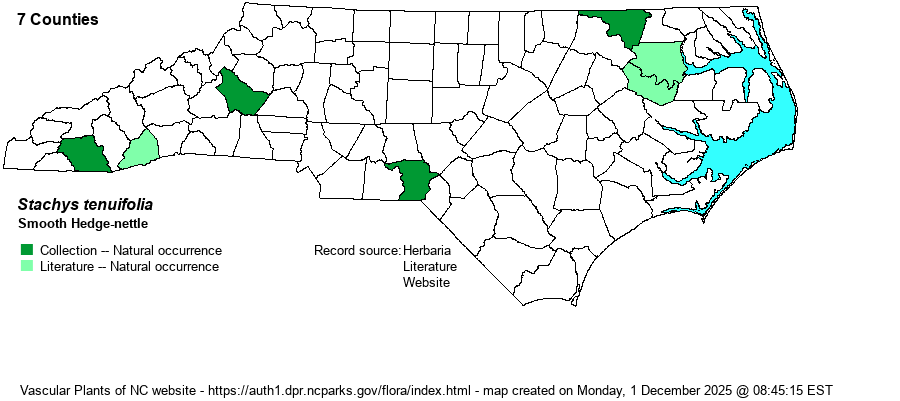| Author | Willdenow | |
| Distribution | Widely present in the state, to an undetermined extent, owing to difficulty in identification of specimens, much less sightings. Distribution is not at all clear; mostly found along the Roanoke River in Bertie, Martin, and Northampton counties. SERNEC lists many montane counties for this species, in addition to a few other downstate; however, most seem to refer to other Stachys species, and the authors limit the collection records on the map essentially to NCU specimens. NOTE: All specimens need updated annotating, because records of tenuifolia used to include latidens, hispida, and aspera.
This is an Eastern species, found from eastern Canada south to the FL Panhandle and eastern TX, but range is spotty overall, owing to confusion with the very similar S. hispida.
| |
| Abundance | Infrequent but locally common along the middle and lower Roanoke River, but seemingly very rare elsewhere in the state. The NCNHP lists it as Significantly Rare, with a State Rank of S1. Owing to uncertainty about the range, the website editors suggest S1S2, at least for now. | |
| Habitat | This is a mostly bottomland forest species, especially along brownwater rivers with rich sediment. Like most members of the genus, it prefers partial shade. It also grows in openings of brownwater swamps, and probably also on wooded stream banks. |
| Phenology | Blooms from June to August, and fruits from September to October. | |
| Identification | This is a rather standard Stachys, with the "stem glabrous to moderately pubescent on the angles" (Weakley 2018), as opposed to the "stem moderately to densely pubescent on the angles with hairs to 3 mm" in S. hispida. The paired leaves have "petioles well developed (1-3 cm long), especially in shade forms" for this species, as opposed to "petioles rarely as much as 1-2 cm long" in S. hispida. This species has "leaves sparsely pubescent or glabrate", as opposed to "leaves usually pubescent above (some forms glabrate)" in S. hispida. Lastly, S. hispida has "Calyx hispiduous to strongly hispid with long, stiff, deflexed hairs", as opposed to "Calyx glabrous to moderately pubescent with short, soft hairs" in S. tenuifolia. In general, S. tenuifolia has a visual look of a species with a fairly long petiole and a rather smooth stem and leaves (and calyx lobes), whereas S. hispida -- which often grows in the same general range -- is a "hairy" species with a short petiole. The other eastern Piedmont and Coastal Plain species -- S. aspera, S. hyssopifolia, and S. matthewsii -- all have nearly sessile leaves or have very short petioles. Much is still to be learned about the identity of Coastal Plain and Piedmont members of the genus! The journal paper by Fleming et al. (2011) has updated keys to all southeastern species. | |
| Taxonomic Comments | A number of references include S. hispida completely within this species or the exact reverse, or some may list these as varieties.
Stachys is a large and complex genus that is still actively being worked on, and our understanding of the species is slowly being clarified. For interested readers, we recommend journal papers by Nelson (1981, 2008) and by Fleming et al. (2011). | |
| Other Common Name(s) | None | |
| State Rank | S1 [S1S2] | |
| Global Rank | G5 | |
| State Status | SR-O | |
| US Status | | |
| USACE-agcp | FACW link |
| USACE-emp | FACW link |

